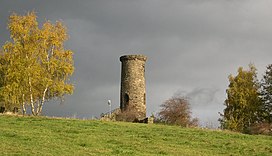Schreckenberg
| Schreckenberg | |
|---|---|
 View of the Schreckenberg ruins on the top of the mountain. | |
| Highest point | |
| Elevation | 648.8 m (2,129 ft)[1] |
| Geography | |
 | |
| Location | Saxony,Germany |
| Parent range | Ore Mountains |
| Geology | |
| Mountain type | gneiss |
TheSchreckenbergis a mountain nearFrohnauin the county ofErzgebirgskreisin thecentral Ore Mountainsof Germany. It is648.8 m abovesea level (NHN)[1].It is located one kilometre northwest of the town ofAnnaberg-Buchholzin the borough of Frohnau.
History
[edit]The mountain is primarily of historical importance, since it is where Annaberg'ssilverore mining began. On 28 October 1491, Caspar Nietzel came across a vein of silver ore not far from theFrohnau Upper Mill.As a result, in 1496, on the opposite bank of the riverSehma,the new town of Neustadt am Schreckenberg grew up, which soon received the name Sankt Annaberg ( "Saint Anna's Mountain" ). In 1498, Annaberg received the right to mint coins from theWettins.The Annaberg Mint was set up in or next to the upper mill and for a short time minted the coin known as theSchreckenberger,a widespread means of payment in theHoly Roman Empire.The sayingYou're a rich Annaberger, you've got a bag full of Schreckenbergersprobably dates to this time. The minting ofGroßgroschen( "big groschen" ) was also carried out in the mints atFreiberg,Leipzig,Dresdenand Saalfeld. The lastSchreckenbergerswere minted in Dresden in 1571. In Annaberg, theSchreckenbergerEngelsgroschenwas only minted until 1547.
The intensive mining activity in the 15th and 16th centuries still characterizes the appearance of the mountain today. Its western flanks in particular are covered by numerous smallspoil heaps.More recent are traces of theuraniummining that was carried out here briefly during the 1950s (Krönung-Fundgrube/Malwine).

Between 1854 and 1856 aRomantic-stylecastleruin was built on the Schreckenberg, which still dominates the view of the mountain today. The castle tower with the remains of ruins indicated was financed from the private funds of wealthy Annaberg townsfolk and by the local companyEisenstuck & Coand was built by the unemployed workers andjourneymen.The Privy Councillor Carl Friedrich Reiche-Eisenstuck is considered the initiator. At a time of severe economic recession, the construction work served in particular as public relief work - in today's sense of ajob creationmeasure.
From the summit there is a good view of the mountain town of Annaberg.
